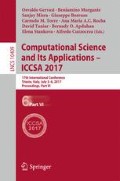Abstract
It is necessary to classify numerical values of spatial data when representing them on a map and so that, visually, it can be clearly understood as possible. Inevitably some loss of information from the original data occurs in the process of this classification. A gate loss of information might lead to a misunderstanding of the nature of original data. In this study, a classification method for organizing spatial data is proposed, in which any loss of information is minimized. When this method is compared with other existing classification methods, some new findings are shown.
Access this chapter
Tax calculation will be finalised at checkout
Purchases are for personal use only
References
Goodchild, M.F., Guoqing, S., Shiren, Y.: Development and test of error model for categorical data. Int. J. Geogr. Inf. Syst. 6(2), 87–104 (1992)
Umesh, R.M.: A technique for cluster formation. Pattern Recogn. 21(4), 393–400 (1988)
MacEachren, A.M.: Some Truth with Maps: A Primer on Symbolization and Design. Association of American Geographers, Washington (1994)
Jenks, G.F.: The data model concept in statistical mapping. Int. Year book Cartography 7, 186–190 (1967)
Andrienko, G., Andrienko, N., Savinov, A.: Choropleth maps: classification revisited, In: Proceedings ICA 2001, Beijing, China, vol. 2, pp. 1209–1219 (2001)
Osaragi, T.: Classification methods for spatial data representation. In: CASA Working Papers 40. Centre for Advanced Spatial Analysis (UCL), London (2002)
Akaike, H.: Information theory and an extension of the maximum likelihood principle, In: Petron, N., Csak, F. (eds.) Proceedings of the 2nd International Symposium on Information Theory, Akademiai kaido, Budapest, pp. 267–281 (1972)
Akaike, H.: A new look at the statistical model identification. IEEE Trans. Autom. Control 19, 716–723 (1974)
Roy, J.R., Batten, D.F., Lesse, P.F.: Minimizing information loss in simple aggregation. Environ. Plann. A 14, 973–980 (1982)
Batty, M.: Spatial entropy. Geogr. Anal. 6, 1–31 (1974)
Batty, M.: Entropy in spatial aggregation. Geogr. Anal. 8, 1–21 (1976)
Andrienko, N., Andrienko, N.: Cumulative curves for exploration of demographic data: a case study of Northwest England. Comput. Stat. 19(1), 9–28 (2004)
Aarts, E., Korst, J.: Simulated annealing and Boltzmann machines, a stochastic approach to combinatorial optimization and neural computing (Wiley Series in Discrete Math. and Optimization), Wiley (1988)
ESRI: ArcView GIS - The Geographic Information System for Everyone. Environmental Systems Research Institute, USA (1996)
Osaragi, T.: Information loss minimization for spatial data representation. J. Architectural Plann. Eng, AIJ 574, 71–76 (2003). (in Japanese)
Acknowledgements
A portion of this paper was published in [15]. The author would like to give his special thanks to Mr. Hiroki Nakayama for computer-based numerical calculations. The authors would like to acknowledge the valuable comments and useful suggestions from reviewers of Scientific Program Committee of ICCSA 2017.
Author information
Authors and Affiliations
Corresponding author
Editor information
Editors and Affiliations
Rights and permissions
Copyright information
© 2017 Springer International Publishing AG
About this paper
Cite this paper
Osaragi, T. (2017). Classification Method by Information Loss Minimization for Visualizing Spatial Data. In: Gervasi, O., et al. Computational Science and Its Applications – ICCSA 2017. ICCSA 2017. Lecture Notes in Computer Science(), vol 10409. Springer, Cham. https://doi.org/10.1007/978-3-319-62407-5_45
Download citation
DOI: https://doi.org/10.1007/978-3-319-62407-5_45
Published:
Publisher Name: Springer, Cham
Print ISBN: 978-3-319-62406-8
Online ISBN: 978-3-319-62407-5
eBook Packages: Computer ScienceComputer Science (R0)

